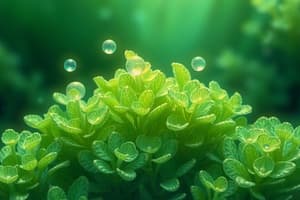Podcast
Questions and Answers
What is the approximate number of species of green algae?
What is the approximate number of species of green algae?
- 3,500-4,000 (correct)
- 7,000-8,000
- 1,000-2,000
- 5,000-6,000
What is the composition of the cell wall of Chlorophyta cells?
What is the composition of the cell wall of Chlorophyta cells?
- Cellulose (correct)
- Cellulose and pectin
- Lignin and hemicellulose
- Chitin and peptidoglycan
What is the primary function of Chlorophyta in aquatic ecosystems?
What is the primary function of Chlorophyta in aquatic ecosystems?
- Modifying water chemistry
- Producing oxygen and serving as a food source (correct)
- Regulating water temperature
- Decomposing organic matter
Which of the following is NOT a type of spore produced by Chlorophyta?
Which of the following is NOT a type of spore produced by Chlorophyta?
Which of the following is an example of a colonial green alga?
Which of the following is an example of a colonial green alga?
What is the evolutionary relationship between Chlorophyta and land plants?
What is the evolutionary relationship between Chlorophyta and land plants?
Flashcards are hidden until you start studying
Study Notes
Chlorophyta
Definition Chlorophyta, also known as green algae, is a division of algae that comprises approximately 3,500-4,000 species of green-pigmented, photosynthetic organisms.
Characteristics
- Cell structure: Chlorophyta cells have a true nucleus, chloroplasts, and a cell wall composed of cellulose.
- Pigmentation: They contain chlorophyll a and b, which give them their green color.
- Reproduction: Chlorophyta can reproduce both sexually and asexually, using zoospores, aplanospores, or autospores.
- Habitat: They are found in freshwater, marine, and terrestrial environments, often in aquatic habitats such as ponds, lakes, and rivers.
Evolutionary Relationships
- Chlorophyta are closely related to land plants, and are thought to have shared a common ancestor.
- They are also related to other groups of algae, such as Charophyta and Ulvophyta.
Importance
- Primary producers: Chlorophyta are important primary producers in aquatic ecosystems, contributing to the food chain and oxygen production.
- Food source: They are a food source for many aquatic animals, including fish and invertebrates.
- Ecological role: Chlorophyta play a key role in maintaining water quality by absorbing excess nutrients and producing oxygen.
Examples of Chlorophyta
- Chlamydomonas: A unicellular, motile green alga that is often used as a model organism in scientific research.
- Volvox: A colonial green alga that forms spherical colonies of cells.
- Ulothrix: A filamentous green alga that is commonly found in freshwater habitats.
Characteristics of Chlorophyta
- Chlorophyta cells have a true nucleus, chloroplasts, and a cell wall composed of cellulose.
- They contain chlorophyll a and b, which give them their green color.
Reproduction in Chlorophyta
- Chlorophyta can reproduce both sexually and asexually.
- They use zoospores, aplanospores, or autospores for reproduction.
Habitat and Distribution
- Chlorophyta are found in freshwater, marine, and terrestrial environments.
- They are often found in aquatic habitats such as ponds, lakes, and rivers.
Evolutionary Relationships
- Chlorophyta are closely related to land plants and shared a common ancestor.
- They are also related to other groups of algae, such as Charophyta and Ulvophyta.
Importance of Chlorophyta
- Chlorophyta are important primary producers in aquatic ecosystems.
- They contribute to the food chain and oxygen production.
- They are a food source for many aquatic animals, including fish and invertebrates.
- Chlorophyta play a key role in maintaining water quality by absorbing excess nutrients and producing oxygen.
Examples of Chlorophyta
Chlamydomonas
- Chlamydomonas is a unicellular, motile green alga.
- It is often used as a model organism in scientific research.
Volvox
- Volvox is a colonial green alga that forms spherical colonies of cells.
Ulothrix
- Ulothrix is a filamentous green alga that is commonly found in freshwater habitats.
Studying That Suits You
Use AI to generate personalized quizzes and flashcards to suit your learning preferences.




